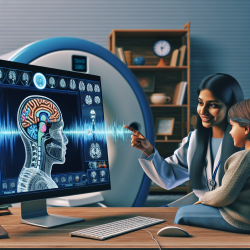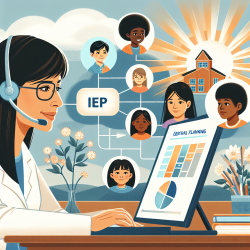Introduction
In the realm of speech-language pathology, the integration of cutting-edge technology can significantly enhance the assessment and intervention strategies for various cognitive and communication disorders. The recent study titled "Neuroimaging and verbal memory assessment in healthy aging adults using a portable low-field MRI scanner and a web-based platform" offers promising insights into the feasibility of remote neuroimaging and cognitive data collection. This blog explores the implications of these findings for practitioners in the field, particularly those working with children, and encourages further research and implementation of these innovative techniques.
Study Overview
The study utilized a portable low-field MRI scanner combined with a web-based platform to assess verbal memory in a diverse population. The findings demonstrated significant associations between brain morphometry and verbal memory performance, highlighting the potential of low-field MRI systems to perform neuroimaging at a participant's home. This approach not only increases accessibility but also engages under-represented communities in neuroimaging research.
Implications for Speech-Language Pathology
For speech-language pathologists, the ability to remotely assess brain structure and function can revolutionize the way we approach therapy, particularly for children with communication disorders. Here are some potential applications:
- Early Detection and Intervention: By identifying structural brain changes associated with verbal memory and cognitive performance, practitioners can tailor interventions more precisely to the needs of each child.
- Remote Therapy Sessions: The integration of remote neuroimaging with online therapy platforms like TinyEYE can facilitate continuous monitoring of a child's progress, allowing for timely adjustments to therapy plans.
- Engaging Diverse Populations: The use of portable MRI technology can help overcome geographical and socioeconomic barriers, ensuring that all children have access to high-quality speech-language services.
Encouraging Further Research
While the study presents promising results, further research is necessary to explore the full potential of low-field MRI in speech-language pathology. Practitioners are encouraged to collaborate with researchers to investigate the following areas:
- The impact of remote neuroimaging on the long-term outcomes of speech and language interventions.
- The feasibility of integrating neuroimaging data into personalized therapy plans for children with diverse communication needs.
- The development of standardized protocols for remote neuroimaging in pediatric populations.
Conclusion
The advancements in remote neuroimaging technology offer exciting opportunities for speech-language pathologists to enhance their practice. By embracing these innovations, practitioners can improve the accuracy of assessments, tailor interventions more effectively, and ultimately create better outcomes for children. To delve deeper into the original research, please follow this link: Neuroimaging and verbal memory assessment in healthy aging adults using a portable low-field MRI scanner and a web-based platform: results from a proof-of-concept population-based cross-section study.










